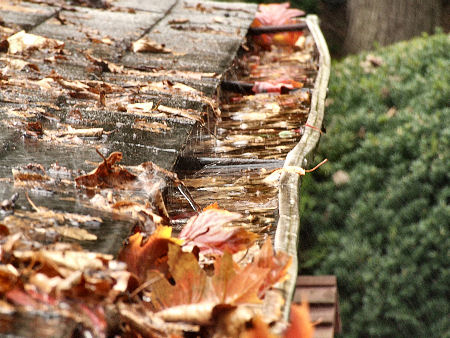While there are gutter protection systems that will limit clogging, all gutter service starts with a thorough cleaning and inspection. The inspection of a gutter system always includes the checking of the slope and volume carrying capacity of the gutters and the downspouts. Too much slope limits carrying capacity (as you will read below). A cursory inspection of all roofing flashings, membranes, overhangs, shingles, etc. should be done also by a roofing professional at the time of gutter cleaning. If the aforementioned items are in question, what good is a gutter system anyway?

Don't let a Rookie Damage Your Property
Gutter cleaning can be more challenging than one would think. A quality job starts with the protection of the gutters, roofing and siding while accessing the gutter system. Proper ladder stand-offs and gutter protection systems should be employed to protect the area being serviced. Too often, gutters, siding and roofing are damaged by the novice that specializes only in gutter cleaning. A gutter cleaner may miss needed service on the roof as the primary focus is cleaning gutters.
The visit by a professional in the industry affords a free roof inspection for the client while the gutters are being cleaned. Often relegated to the untrained, gutter cleaning is often last on the list of priorities, when it should be first. Wet basements, mold, mildew, rot, roof failure, foundation damage, insect and vermon infiltration and loss of gutter function are just some of the consequences of lack of timely and quality service to your gutters.

A note on Gutter Protection Systems: Every Gutter Protection System, or Gutter Screen or Gutter Covering causes a deficit in gutter effectiveness. Every system has its limitations either in catching the debris, or in the limiting of water flow into the gutters. Every system allows some debris to enter the system and the gutters must be accessed at some time to clean them. No system is 100% effective, no matter what the claims by the manufacturer. If it were so and a system did provide a 100% protection, the limit on water flow would be such that the gutters would no longer function. There are good systems that can limit the cleaning needed. Each system must be evaluated as to the amount of water carried and the debris to be filtered. No system works well for every situation. It would be great if there was a solution that would eliminate gutter cleaning, but such a system does not exist. All gutters must be cleaned. Even on the best of situations, a silt-like layer of decomposing material will cling to the bottom of the gutter. When this layer is wet, it is slimy and it stays level on the bottom of the gutter where no limit to function is realized. It is as the weather goes through a dry phase where this material dries and cracks in large and hard pieces awaiting a good rain where these formations move and cause downspout outlet blockage. A heavily sloped gutter will exaggerate this effect as increased velocity within the gutter causes any objects contained within to slam toward the drain all at once.
A note on Slope of Gutter: Often gutters are over-sloped in an effort to discharge water faster. This works for the intended purpose, however the ability of a given gutter to hold the water from a rain event for evacuation is compromised. The effects of over-sloping a gutter are not only a loss of effectiveness in that even a larger gutter becomes able to handle less water, but clogging from the aforementioned dried silt-like deposits is accentuated. Overflow of the gutter is inevitable when gutters are sloped too much. The job of a gutter is to hold and direct roof water run-off to a designated area without overflow. Only a small amount of slope is required for a gutter system to work properly. No benefit can be realized from over-sloping a gutter system.
A note on Downspouts Emptying Into Lower Gutters: If at all possible, upper downspouts should not drop into a lower gutter. All downspouts should drop to the ground, if at all possible. Water running vertically and at high velocity should not be channeled into a lateral gutter. First, water splashes from the shock of being slowed to a stop at the gutter. Water will at this point spill-over the gutter. Once the water bounces around and begins to find its way to toward the lower spout, the addition of the lower runoff causes a buildup that usually leads to failure at some point in time.
A note on Gutter Miters: Gutter Miters are equivalent to about 12 to 15 feet of gutter run in impedance of water flow. Gutter Miters are potential problem areas as they inhibit the flow along the slope of a given gutter. A given necessity, they are needed in areas under hip roofs, etc., but they should not be added to direct water flow or for aesthetics when a downspout elbow will suffice for proper water evacuation.
A note on Gutter Sizing: There are calculations for sizing of gutters and downspouts. Here is a link to information that will help in designating the sizing of gutters and spouts. We always recommend going larger if for only the downspouts because larger outlets tend to clog less.
Call us for a free gutter, roof, foundation, siding and drainage inspection with your gutter cleaning. |


